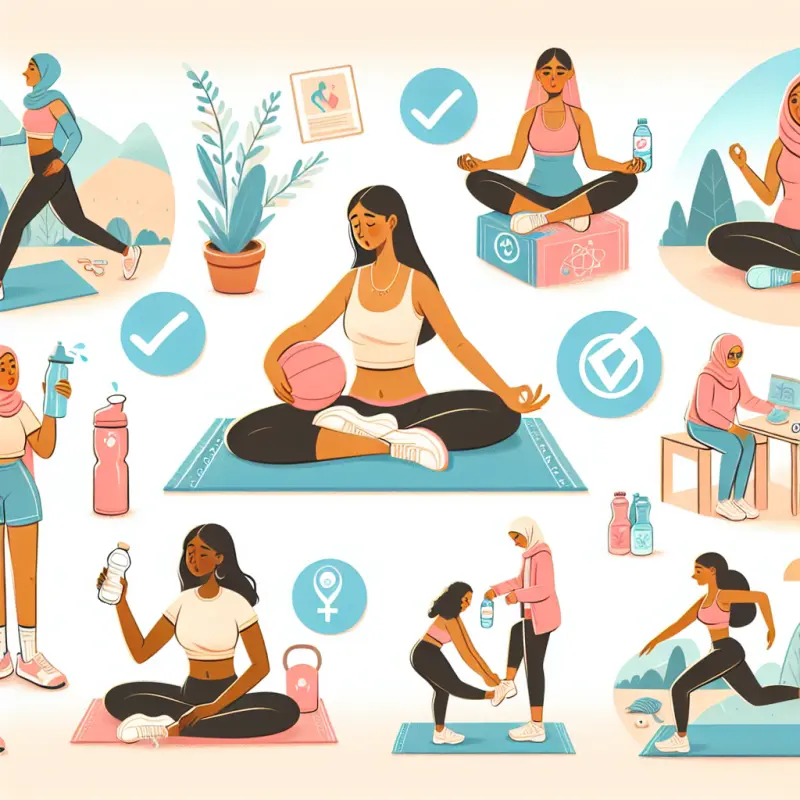Exercise Safety Tips for Your Period

Exercise Safety Tips for Your Period
Introduction
Exercising during your menstrual cycle can sometimes feel like a daunting task. The discomfort, cramps, and mood swings often make the couch seem far more inviting than the gym. However, maintaining an exercise routine during your period can be beneficial. It helps in alleviating menstrual symptoms, improving mood, and boosting energy levels. But like any physical activity, it's crucial to prioritize safety to ensure that your workout is effective and doesn't exacerbate any discomfort. This article will explore exercise safety tips for your period, helping you navigate your fitness journey with confidence and care.
Understanding Your Menstrual Cycle
Before delving into exercise tips, it's essential to understand the phases of the menstrual cycle, as they can influence how you feel and perform during workouts.
The Menstrual Phase
- Duration: 3-7 days
- Characteristics: Shedding of the uterine lining, leading to bleeding.
- Symptoms: Fatigue, cramps, and mood swings are common.
The Follicular Phase
- Duration: 7-10 days post-menstruation
- Characteristics: Rising estrogen levels, leading to increased energy and improved mood.
- Benefits for Exercise: Many women feel more energetic and can handle more intense workouts.
The Ovulatory Phase
- Duration: 3-5 days
- Characteristics: Peak estrogen and testosterone levels.
- Benefits for Exercise: Optimal strength and performance; a good time for high-intensity workouts.
The Luteal Phase
- Duration: 10-14 days post-ovulation
- Characteristics: Increased progesterone, possible bloating, and mood changes as the body prepares for menstruation.
- Exercise Considerations: Energy levels may fluctuate; moderate exercises are recommended.
Safety Tips for Exercising During Your Period
1. Listen to Your Body
- Pay Attention to Signals: Your body is your best guide. Pay attention to how you feel before, during, and after workouts.
- Adjust Intensity: If you're feeling fatigued or experiencing severe cramps, consider lowering the intensity of your exercise.
2. Choose the Right Types of Exercises
Different exercises can have varying impacts on your body during your period. Here are some recommendations:
- Low-Impact Exercises: Walking, cycling, and swimming are great for maintaining fitness without putting too much strain on your body.
- Yoga and Pilates: These can help reduce cramps and improve mood through gentle stretching and mindful breathing.
- Strength Training: If you're up for it, light to moderate weightlifting can help maintain muscle tone without overexerting yourself.
3. Stay Hydrated
- Importance of Hydration: Menstruation can cause fluid loss, making it essential to stay hydrated to prevent fatigue and dizziness.
- Hydration Tips: Aim to drink at least 8-10 glasses of water a day, and consider hydrating sports drinks if you're engaging in prolonged exercise sessions.
4. Nutrition for Energy
- Balanced Diet: Focus on a diet rich in iron, magnesium, and omega-3 fatty acids to combat fatigue and reduce inflammation.
- Healthy Snacks: Incorporate snacks like nuts, fruits, and yogurt to maintain energy levels throughout your workout.
5. Proper Attire
- Comfortable Clothing: Wear loose-fitting, breathable clothes to accommodate any bloating and ensure comfort.
- Supportive Gear: Invest in a good quality sports bra and comfortable shoes for adequate support and injury prevention.
6. Warm-Up and Cool Down
- Importance: Warming up prepares your body for exercise, while cooling down aids in recovery.
- Routine: Spend at least 5-10 minutes on each, incorporating dynamic stretches to loosen muscles and prevent cramps.
7. Manage Discomfort
- Pain Relief: Consider over-the-counter pain relievers like ibuprofen if cramps are severe, but consult a healthcare professional first.
- Heat Therapy: Use heating pads or warm baths post-exercise to soothe sore muscles and relieve menstrual cramps.
8. Rest When Needed
- Prioritize Rest: If you're feeling unwell, give yourself permission to rest. Pushing through severe discomfort can lead to injuries and prolonged recovery.
- Sleep Quality: Ensure you're getting enough sleep to aid in recovery and maintain energy levels.
Special Considerations
Exercising with Heavy Flow
- Plan Accordingly: Opt for exercises that allow frequent bathroom breaks if necessary.
- Hygiene Products: Use high-absorbency hygiene products or menstrual cups to prevent leakage during workouts.
Mental Health and Motivation
- Stay Positive: Remember that it's okay to have low-energy days. Focus on what you can do rather than what you can't.
- Set Realistic Goals: Adjust your fitness goals to match your energy levels and be kind to yourself.
Conclusion
Exercising during your period can be a highly beneficial practice, helping to alleviate symptoms and improve overall well-being. By understanding your menstrual cycle and implementing these exercise safety tips, you can continue your fitness journey with confidence and care. Remember that every woman's body is different, and it's crucial to listen to your own unique needs. Whether it's a gentle yoga session or a brisk walk, the key is to stay active while prioritizing your comfort and safety. Embrace the power of movement and let it be a supportive ally through every phase of your cycle.